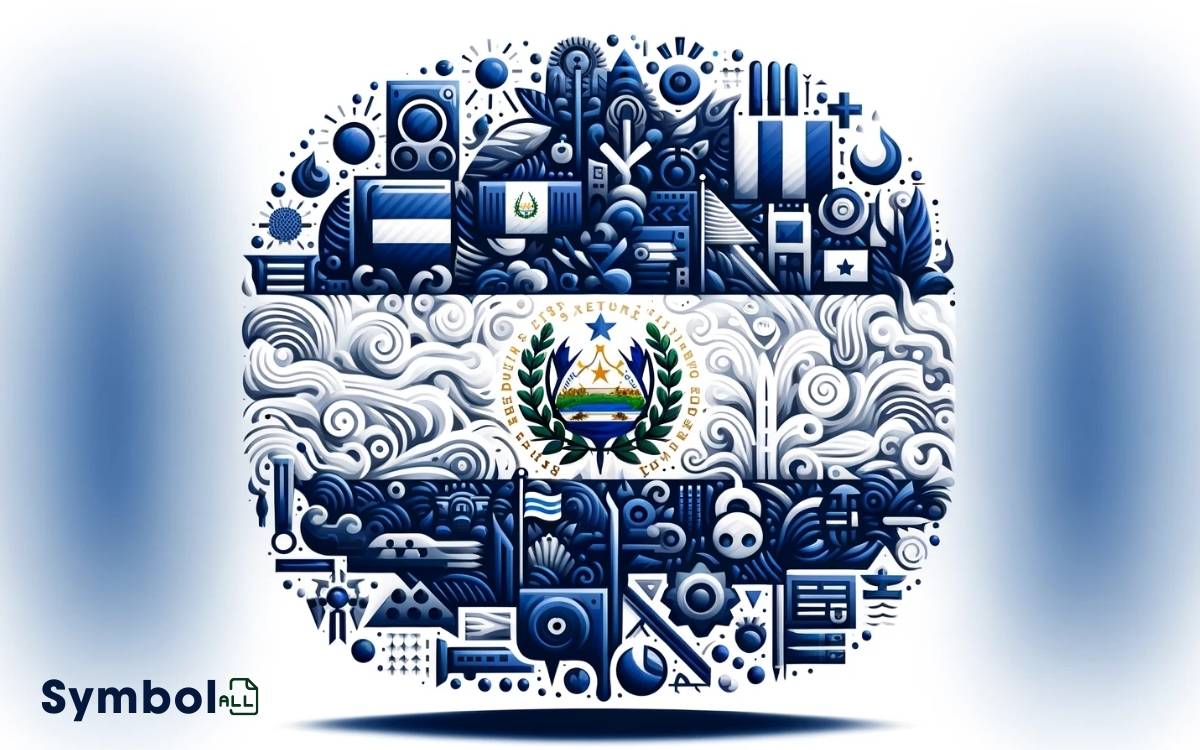El Salvador Flag Meaning Symbols and Colors: Resilience!
El Salvador’s flag symbolizes your country’s resilience and unity. Its blue and white stripes mirror historical decisions, aiming to break from colonial chains and embrace autonomy, influenced by the Federal Republic of Central America.
You’ll see the national coat of arms at its heart, representing equality and government branches, with volcanoes signifying unity among states, and a phrygian cap symbolizing liberty’s pursuit.
Blue reflects brotherhood and justice, white for peace and purity, and golden amber for the nation’s riches.
This flag tells a story of struggle, unity, and hope, shaping your collective identity and fostering pride. Unpacking this narrative further reveals deeper insights into El Salvador’s soul.

Key Takeaways
Historical Background
El Salvador’s flag, often seen as a symbol of unity and resistance, has undergone several transformations since its inception in the early 19th century, reflecting the nation’s tumultuous and rich historical journey.
Initially, the quest for independence from Spanish rule marked the early versions of the flag, symbolizing the birth of a new, sovereign nation.
As you investigate further, you’ll find that each alteration to the flag’s design mirrors significant political and social shifts within the country.
The adoption of different emblems and colors over time wasn’t merely aesthetic; it was deeply entwined with El Salvador’s identity, embodying the aspirations, struggles, and resilience of its people.
This evolution speaks volumes, offering you a nuanced understanding of how historical contexts shape national symbols.
Flag Overview
As you shift from the historical context of El Salvador’s flag, it’s vital to understand the elements that compose its current design.
You’ll find that each aspect, from its origins to the colors, carries profound meanings that reflect the nation’s identity and values.
Analyzing these components won’t only deepen your appreciation of the flag but also offer insights into the cultural and political ethos of El Salvador.
Flag Design Origins
The design of El Salvador’s flag, rooted in historical significance and symbolism, reflects the country’s identity and values. This flag, adopted officially on May 27, 1912, has a deep connection to the nation’s past, particularly its struggle for independence and unity.
- Influences from the Federal Republic of Central America: El Salvador’s flag design closely mirrors that of the former federation, symbolizing a continued aspiration for Central American unity.
- Adaptation and Evolution: Over the years, the flag has undergone several modifications, each reflecting a specific era in the nation’s history, embodying its evolving identity.
- Colors with Purpose: The choice of blue and white stripes is deliberate, representing the sky and peace, a nod to the hopes of its people for harmony and freedom.
Analyzing the origins of El Salvador’s flag uncovers a rich tapestry of historical narratives and aspirations, offering insight into the nation’s collective psyche.
Symbolic Meanings Unveiled
Delving deeper into El Salvador’s flag, we uncover the layers of symbolism that narrate the nation’s aspirations and historical journey.
The flag’s core, adorned with the national coat of arms, serves as a symbolic gateway to the country’s soul. This emblem, a triangle, represents equality and the three branches of government, underscoring the nation’s commitment to democratic principles.
The five volcanoes within it symbolize the unity among the five member states of the Federal Republic of Central America, highlighting historical bonds and shared heritage.
The phrygian cap atop the emblem signifies the pursuit of liberty, a poignant reminder of the struggle for independence.
Together, these elements weave a narrative of resilience, unity, and sovereign identity, painting a vivid picture of El Salvador’s ethos and aspirations.
Color Significance Explained
Uncovering the layers of El Salvador’s flag reveals a rich tapestry of color, each hue imbued with deep significance that mirrors the nation’s cultural and historical essence.
As you explore the flag’s palette, you’ll find each color speaks volumes about El Salvador’s identity:
- Blue: Represents the sky and the two oceans that border Central America, symbolizing brotherhood, perseverance, and justice. It’s a nod to the nation’s hope and vigilance.
- White: Embodies peace, purity, and solidarity. It acts as a bridge between the two blue stripes, signifying unity and the aspiration for harmony within the country.
- Golden Amber: Found within the coat of arms, this color highlights the nation’s riches—both in spirit and in natural resources, echoing a legacy of wealth and resilience.
Each layer of color contributes to a narrative of struggle, unity, and undying hope, painting a picture of El Salvador’s past, present, and aspirations for the future.
Color Significance
You must understand that the colors of the El Salvador flag aren’t arbitrary; they carry deep symbolic interpretations rooted in the nation’s past.
The blue stripes encapsulate hope and the vastness of the sky, while the white stripe represents peace, purity, and unity among Salvadorans.
Analyzing the historical color evolution reveals shifts in political and cultural ideologies, reflecting the dynamic history of El Salvador.
Symbolic Color Interpretation
Each color of the El Salvador flag carries a profound symbolic significance that mirrors the country’s history, culture, and values. When you explore the colors, you’re not just looking at hues; you’re revealing the essence of what El Salvador stands for.
- Blue: Symbolizes the sky and the two oceans that flank Central America, reflecting aspirations of solidarity and peace among the nations.
- White: Represents purity, integrity, and the aspiration towards peace, acting as a reminder of the importance of working for harmony within the country.
- Gold (Coat of Arms): Embodies the country’s rich history, resilience, and the quest for freedom and justice.
Understanding these colors gives you a deeper appreciation for the flag, as each shade encapsulates key aspects of Salvadoran identity and ideals.
Historical Color Evolution
Having explored the symbolic significance of the El Salvador flag’s colors, it’s now important to examine how these colors have evolved over time to encapsulate the nation’s historical journey.
Initially, the flag’s colors were chosen for specific reasons tied to the country’s landscape and ideals of freedom. Over the years, these hues have deepened, reflecting a maturation of national identity and resilience.
The cobalt blue, once a lighter shade, now embodies a richer depth, signifying the Pacific Ocean’s vastness and the sky’s limitlessness, symbolizing ambition and hope.
The white has maintained its purity but has gained a significance of peace and unity, mirroring the country’s efforts towards harmony. This evolution mirrors El Salvador’s growth, through struggles and triumphs, weaving a story of persistence and unity into the fabric of its flag.
Cobalt Blue Stripes
The cobalt blue stripes on El Salvador’s flag symbolize the Pacific Ocean and the sky, reflecting the country’s commitment to peace and solidarity.
This choice of color isn’t just aesthetically pleasing; it’s steeped in meaning and context, revealing much about El Salvador’s values and aspirations.
- Geographical Significance: The blue represents the vast Pacific Ocean that graces El Salvador’s coastline, highlighting the nation’s geographical identity and natural beauty.
- Symbol of Peace: Embodying the sky, the blue stripes evoke a sense of calm and tranquility, illustrating El Salvador’s desire for harmony within and beyond its borders.
- Solidarity and Unity: These stripes serve as a reminder of the country’s solidarity, binding its people together under a shared sky and common heritage.
Through these stripes, El Salvador communicates its core values and connects deeply with its citizens and the broader global community.
The Central White Stripe
You’ll find that the central white stripe on El Salvador’s flag isn’t just a design element; it’s a profound symbol of peace and unity.
This stripe signifies El Salvador’s role in Central America, highlighting its aspiration for harmony amidst diversity.
It serves as a reminder that despite different backgrounds and beliefs, there’s a shared vision of unity and cooperation.
Peace and Unity Symbol
Central to El Salvador’s flag, the white stripe symbolizes the nation’s enduring commitment to peace and unity. This emblematic representation offers a profound insight into the values that El Salvador cherishes.
Delving into its significance:
- Purity and Harmony: The white color reflects a desire for purity in intentions and harmony among its citizens.
- Bridge Between Extremes: Positioned between two bold colors, it acts as a mediator, advocating for balance and moderation.
- Unity in Diversity: It signifies the country’s aspiration to unify its diverse population, irrespective of political or social differences.
Analyzing this element reveals El Salvador’s dedication to fostering a peaceful coexistence and a united national identity. It’s a powerful reminder of the country’s commitment to creating an inclusive society where every individual can thrive.
Representing Central America
Exploring further, the central white stripe on El Salvador’s flag also embodies the country’s role in representing Central America, illustrating its commitment to regional unity and peace.
This stripe serves as a visual metaphor, signifying El Salvador’s dedication to acting as a bridge within the Central American isthmus.
It’s not merely a design element but a profound representation of the nation’s aspirations and responsibilities towards fostering a peaceful and united region.
| Element | Significance |
|---|---|
| White Stripe | Peace and Unity |
| Central Position | Central American Representation |
| Visual Metaphor | Bridge in Central America |
Diversity in Harmony
The central white stripe on El Salvador’s flag symbolizes not only peace and unity but also the rich diversity that thrives within its borders, harmoniously blending various cultures and traditions.
This emblematic feature mirrors the country’s commitment to embracing differences, fostering a sense of belonging among its people.
By analyzing this symbol, you uncover layers of El Salvador’s societal fabric, highlighting:
- Cultural integration: Acknowledging indigenous roots alongside European influences.
- Social cohesion: Promoting unity among diverse communities.
- Inclusivity: Encouraging equal participation in the nation’s development.
The white stripe, as a result, isn’t just a design element; it’s a profound representation of El Salvador’s core values, illustrating how diversity, when embraced, creates a stronger, more cohesive society.
National Coat of Arms
Within the heart of El Salvador’s flag lies its National Coat of Arms, a symbol rich in history and meaning that reflects the country’s identity and values. This emblem isn’t just an arbitrary design; it’s a narrative condensed into imagery.
You’ll notice the Coat of Arms features a triangle representing equality and the three branches of government.
Inside, five flags are raised, symbolizing the original five member states of the Federal Republic of Central America, highlighting El Salvador’s roots and its connection to its neighbors.
The words ‘Dios, Unión, Libertad‘ encircle the triangle, a motto that translates to ‘God, Union, Freedom,’ encapsulating the nation’s core principles. This emblem serves not just as a national symbol but as a reminder of the country’s aspirations for democracy, unity, and liberty.
Five Central American Volcanoes
Reflecting on the National Coat of Arms, it’s clear that El Salvador’s identity is deeply intertwined with its geographical features, strikingly the five Central American volcanoes that stand as monumental landmarks across the region.
These volcanoes aren’t just physical entities; they symbolize resilience, natural beauty, and geological significance.
- Resilience: These volcanoes have withstood the test of time, embodying the enduring spirit of the Central American people.
- Natural Beauty: Their imposing presence and lush surroundings contribute to the region’s breathtaking landscapes.
- Geological Significance: Each volcano tells a unique story of Earth’s fiery past, offering clues about seismic activities and ecological evolution.
Understanding the symbolism behind these volcanoes enriches your appreciation for El Salvador’s flag, where every element holds deep meaning.
The Phrygian Cap
At the heart of El Salvador’s flag symbolism, you’ll find the Phrygian cap, emblematic of freedom and the republic’s revolutionary history.
This cap isn’t just a casual hat; it’s a powerful symbol of liberty, often depicted in red to signify the blood and sacrifice of those who fought for the nation’s independence. Its presence atop the flag is a constant reminder of the struggle and victory against oppression.
| Feature | Details | Symbolism |
|---|---|---|
| Color | Red | Sacrifice, courage |
| Position | Centered | Unity, focus |
| Orientation | Forward | Progress, looking ahead |
| Background | Blue and white stripes | Peace, purity |
| Association | Coat of Arms | National identity |
The cap’s forward tilt emphasizes a nation always moving towards progress, with its colors and placement reinforcing themes of unity, purity, and a steadfast commitment to national identity.
The Rainbow of Peace
Moving from the representation of struggle and freedom symbolized by the Phrygian cap, the Rainbow of Peace in El Salvador’s flag embodies the nation’s aspirations for harmony and unity after periods of conflict.
This colorful symbol serves as a beacon of hope, reflecting a collective wish for a serene future.
Here’s what it signifies:
- Aspirations for Harmony: It represents the desire to live in a society where peace prevails over war and conflict.
- Unity in Diversity: The rainbow’s diverse colors symbolize the inclusion and acceptance of different cultures and communities within the nation.
- Hope for the Future: It embodies optimism for a peaceful and prosperous future, where past conflicts have paved the way for reconciliation and growth.
The Golden Amber Words
Why do the Golden Amber Words inscribed on El Salvador’s flag hold profound significance for its people?
These words, rendered in a shade that evokes the country’s rich, earthy landscapes, aren’t merely decorative. They’re a declaration of identity and affirmation, deeply rooted in El Salvador’s history and aspirations.
Each letter, gleaming against the flag‘s fabric, is a confirmation to the nation’s enduring spirit and its collective journey towards sovereignty and dignity.
This textual component transcends mere symbolism; it’s a rallying cry for unity, a reminder of battles fought for freedom, and an emblem of the resilience that characterizes Salvadoran society.
For you, the observer, these words offer a window into the soul of a nation, encapsulating its struggles, victories, and hopes in a few powerful strokes.
Symbols of Prosperity
El Salvador’s flag proudly showcases symbols of prosperity, each intricately woven into its fabric to reflect the nation’s abundant natural resources and the industrious spirit of its people.
These symbols serve as a constant reminder of the country’s commitment to progress and economic vitality. They aren’t just ornaments but representations of El Salvador’s rich heritage and its aspirations for a prosperous future.
- The Blue Bands: Symbolize the Pacific Ocean and the sky, highlighting the nation’s reliance on these natural resources for economic activities like fishing and tourism.
- The White Stripe: Represents peace, a foundational element for prosperity by ensuring a stable environment for economic development.
- The Coat of Arms: Features a triangle symbolizing equality and the five member countries of the United Provinces of Central America, pointing towards unity and regional cooperation as key to prosperity.
These elements collectively underscore El Salvador’s journey towards growth and prosperity, deeply rooted in its natural endowments and the unity of its people.
The Flags Evolution
Over the years, El Salvador’s flag has undergone several transformations, each reflecting shifts in the nation’s identity, politics, and aspirations.
Initially, the flag’s design was influenced by Spanish colonial rule, featuring the colonial colors and emblems. However, as El Salvador moved towards independence, there was a deliberate shift to distinguish its flag from its colonial past.
This evolution wasn’t merely cosmetic; it symbolized the country’s growing sense of autonomy and the desire to forge a unique national identity.
The introduction of the blue and white stripes was a pivotal change, representing peace, solidarity, and the sky and ocean that surround the nation.
Each alteration in design was a strategic decision, aiming to encapsulate and communicate El Salvador’s evolving ethos and values to the world.
Cultural Impact
The flag of El Salvador, with its vibrant colors and emblematic design, deeply influences the cultural identity and national pride of its people. This profound impact is evident in several areas:
Public celebrations: The flag is omnipresent during national holidays, serving as a symbol of unity and remembrance. It’s a reminder of the country’s struggle for freedom and its achievements.
Art and literature: Salvadoran artists and writers often draw inspiration from the flag, incorporating its elements into their works to express nationalistic themes and reflect on the nation’s history.
Education: In schools, the flag’s meaning and history are taught as part of the curriculum, instilling a sense of patriotism and respect for the country’s heritage from an early age.
Understanding this cultural significance helps to appreciate the depth of connection between the Salvadoran people and their flag.
Conclusion
Essentially, the flag of El Salvador isn’t just a piece of fabric; it’s a colossal tapestry of history and aspiration, woven with threads of indomitable spirit and pride.
The cobalt blue stripes serve as a boundless ocean, embodying dreams and perseverance, while the white stripe stands as a beacon of peace in a tumultuous world.
The golden amber words aren’t mere text; they’re the very essence of Salvadoran resilience, echoing through ages.
This flag, in its evolution, has transcended mere national identity, becoming a symbol of cultural richness and unyielding prosperity that resonates profoundly in the heart of every Salvadoran.






